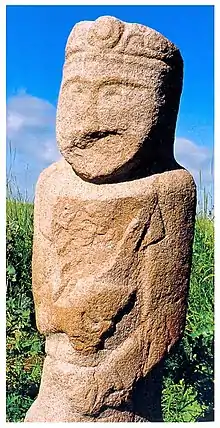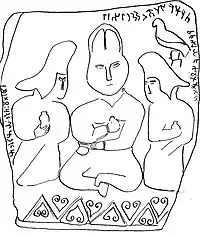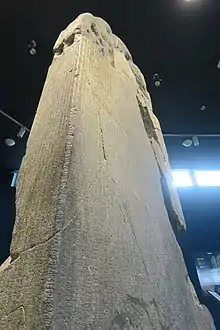Ashina tribe
The Ashina (Chinese: 阿史那; pinyin: Āshǐnà; Wade–Giles: A-shih-na; Middle Chinese: (Guangyun) [ʔɑʃi̯ə˥nɑ˩]), also known as Asen, Asena, or Açina, were a tribe and the ruling dynasty of the ancient Turkic peoples. It rose to prominence in the mid-6th century when the leader, Bumin Qaghan, revolted against the Rouran Khaganate. The two main branches of the family, one descended from Bumin and the other from his brother Istämi, ruled over the eastern and western parts of the Göktürk confederation, respectively.
阿史那 Āshǐnà | |
|---|---|
 | |
| Regions with significant populations | |
| Central and East Asia | |
| Languages | |
| Old Turkic[4] | |
| Religion | |
| Tengrism[5][6] Buddhism (minority)[7][8] |
Origin
Primary Chinese sources ascribed different origins to the Ashina tribe. Ashina were first attested to 439, as reported by the Book of Sui: on October 18, the Tuoba ruler Emperor Taiwu of Northern Wei overthrew Juqu Mujian of the Northern Liang in eastern Gansu,[9][10][11][12] and 500 Ashina families fled northwest to the Rouran Khaganate bear Gaochang.[9][13] According to the Book of Zhou, History of the Northern Dynasties, and New Book of Tang, the Ashina clan was a component of the Xiongnu confederation.[14][15][16][17] but this is contested.[18] Göktürks were also posited as having originated from an obscure Suo state (索國), north of the Xiongnu.[14][15] According to the Book of Sui and the Tongdian, they were "mixed barbarians" (雜胡; záhú) from Pingliang.[9][19]
According to some researchers (Duan, Xue, Tang, Lung, Onogawa, etc.) the Ashina tribe were descended from the Tiele confederation,[20][21][22][23][24] who were likewise associated with the Xiongnu.[25][26] Like the Göktürks, the Tiele were probably one of many nomadic Turkic peoples on the steppe.[27][28]
Etymology
Several researchers, including Peter B. Golden,[29] H. W. Haussig,[30] S. G. Klyashtorny,[31][32] Carter V. Findley,[33] D. G. Savinov,[34] S. P. Guschin,[35] and András Róna-Tas[36] have posited that the term Ashina is from the Iranian Saka or possibly from the Indo-Aryan Wusun.[37]
Carter V. Findley assumes that the name "Ashina" comes from one of the Saka languages of central Asia and means "blue" (gök in Turkic). The color is identified with the east, so that Göktürk, another name for the Turkic empire, meant the "Turks of the East".[38] This idea is seconded by Hungarian researcher András Róna-Tas, who finds it plausible "that we are dealing with a royal family and clan of Saka origin".[39] "The term bori, used to identify the ruler's retinue as 'wolves', probably also derived from one of the Iranian languages", proposes Findley.
H. W. Haussig and S. G. Kljyashtorny suggest an association between the name and the compound "kindred of Ashin" ahşaẽna (in Old Persian). This is so even in East Turkestan; then the desired form would be in the Sogdian 'xs' yn' k (-әhšēnē) "blue, dark"; Khotan-Saka (Brahmi) āşşeiņa (-āşşena) "blue", where a long -ā- emerged as development ahş-> āşş-; in Tocharian A āśna- "blue, dark" (from Khotan-Saka and Sogdian). There is a textual support for this version in the ancient runic inscriptions of the Turks.
In the large Orkhon inscriptions, in the story of the first Kagan, people living in the newly created empire are named "kök türk" (translated as "Celestial Turks"). Without touching the numerous interpretations "kök" may have in this combination, note its perfect semantic match with the reconstructed value of the name "Ashina". An explicit semantic calque suggests knowledge of its original meaning and foreign origin, which is compatible with the multi-ethnic, multi-cultural nature of the First Turkic Khaganate, which entailed the loss, however, of the popularity of "national character", in the words of L. Bazin, as was the political and cultural environment of the Otuken regime in the era of Bilgä Qaǧan.
The name "Ashina" was recorded in ancient Arab chronicles in these forms: Aś(i)nas (al-Tabari), Ānsa (Hudud al-'Alam), Śaba (Ibn Khordadbeh), Śana, Śaya (Al-Masudi).[40][41] The name "Ashina" is translated by some researchers as "wolf", cf. Tuoba 叱奴 *čino, Middle Mongol činua, Khalkha čono.[42][43] However, Golden contended that derivation from Mongolic is mistaken.[44] When Ashina became the head of Göktürks, they exhibited a banner with a wolf head over their gate, in reminiscence of its origins.[45]
Legends
Chinese chroniclers recorded four origin tales, which Golden termed "Wolf Tale I", "Wolf Tale II", "Shemo (Žama) and the Deer Tale" and "Historical Account", of the Turks in dynasty histories and historical compilations "based on or copied from the same source(s) and repeated in later collections of historical tales".[44]
- Wolf Tale I: Ashina was one of ten sons born to a grey she-wolf (see: Asena) in the north of Gaochang.[46]
- Wolf Tale II: The ancestor of the Ashina was a man from the Suo nation (north of Xiongnu) whose mother was a lupine season goddess.[46]
- Shemo and the Deer Tale: The Ashina descended from a skilled archer named Shemo, who had once fallen in love with a sea goddess west of Ashide cave.[47]
- Historical Account: The Ashina were mixture stocks from the ]Pingliang commandery of eastern Gansu.[48]
These stories were sometimes pieced together to form a chronologically coherent narrative of early Ashina history. However, as the Book of Zhou, the Book of Sui, and the Youyang Zazu were all written around the same time, during the early Tang dynasty, it is debatable whether they could truly be considered chronological or rather should be considered competing versions of the Ashina's origin.[49] The record of Turks in Zhoushu (written in the first half of the seventh century) describes the use of gold by Turks around the mid-fifth century: "(The Turks) inlaid gold sculpture of wolf head on their flag; their military men were called Fuli, that is, wolf in Chinese. It is because they are descendants of the wolf, and naming so is for not forgetting their ancestors."[46]
According to Klyashtorny, the origin myth of Ashina shared similarities with the Wusun, although there is a significant difference that, whereas in the Wusun myth the wolf saves the ancestor of the tribe, it is not as in the case of the Turks. He also adds that Turk system of beliefs linking at least some sections of the Turk ruling class to the Sogdians and, beyond them, to the Wusun.[37]
Funeral rite
The Old Book of Tang describes the funeral rites of the Ashina as follows:
- "The body of the deceased lived in a tent. Sons, grandchildren and relatives of both sexes slaughter horses and sheep, and as they spread around in front of the tent, sacrifice; they ride on horseback seven times around the tent, and then, at the entrance to the tent, slit their own faces with a knife weeping, and spill their blood forward; pouring blood and tears collectively. They do so seven times, and it is over. Later in the chosen day they take the horse on which the deceased used to ride, and the things that he used, and burn them along with the corpse: the ashes are then collected and buried in a certain season into the grave. Those who died in the spring and summer, are buried when the leaves on the trees and plants begin to turn yellow and fall; those who died in the fall or winter are buried when the flowers begin to unfold. On the day of the funeral, as well as on the day of his death, the family offers a sacrifice, rides horses and slit their face. The building, which was built on the grave, is decorated with the portrait of the face of the dead man and with the description of battles in which he was as in the continuation of life. Usually they put one stone for every man he killed, they may have a different number of such stones, up to a hundred or even a thousand. when bringing sheep and horses as a sacrifice to a single, they hang their heads on the milestones."
According to D. G. Savinov, no archaeological monument is fully consistent with the description given by I. Bichurin, neither South Siberia nor Central Asia is known yet, although many of its elements are found already in the early Turkic time. According to D. G. Savinov this may be for several reasons:
- Göktürk burial sites in Central Asia and Southern Siberia are not yet open;
- The source is a compilation in character, and burial rituals and funeral cycle from various sources are listed in a unified description;
- Göktürk funeral rites in the form in which it is recorded in written sources, developed later on the basis of the various components present in some of the archaeological sites of Southern Siberia of early Turkic time.
It is certain that the rite of cremation was adopted among Turkic Hagan and a very narrow ruling stratum of kaganates. Rite of cremation did not spread among the common people of Turkic. This may well be at the origin of the other ethnic groups of the ruling family.[50]
Almost all of the elements of the funeral rites of the Ashina have analogues in the Indo-European rites, in particular the Slavic rites. About individual incision, Al-Bakr can be quoted: "Wives of the same dead cut their hands and faces with knives." A Chinese source said that on the day of the funeral, as well as in the day of his death, the family rode horses. There is likely to have in mind something like a Slavic funeral feast. "The building was built on the grave" is an analogue of the Slavic Domowina. The ashes of the deceased were buried in a vessel (the tomb of Kul Tigin and his wife) as is recorded by the Slav's "Tale of Bygone Years", for example where it says: "burned, and after collecting the bones, put them in a small container."
Genetics
Based on testings on persons who identify themselves as descendants of Bumin Qaghan, the Ashina clan belongs to the Z93, Z94+, Z2123-, Y2632- branch of haplogroup R1a.[35] According some researchers, the Bulgar Asen dynasty might be descendants of Ashina.[51] Another prominent turkic clan Ashide is also the conjugal clan of the Göktürk khagans' Ashina clan has Q1a-L53.[35]
Gallery

 Memorial complex of Altyn Tamgan Tarhan, (son of Ashina Duoxifu) 732 AD. Ibex Tamga can be seen. Bulgan Province, Mongolia[52]
Memorial complex of Altyn Tamgan Tarhan, (son of Ashina Duoxifu) 732 AD. Ibex Tamga can be seen. Bulgan Province, Mongolia[52]
See also
- Timeline of Turks (500–1300)
- Turks in the Tang military
- Mythology of the Turkic and Mongolian peoples
- Shǐ (surname), (史) adopted by some of the Ashina tribe
Notes
- International Turkic Academy, (2015), TÜRK BENGÜ TAŞI: Şivеet-Ulаan Damgalı Anıtı, p. 13 (in Turkish)
- Grač, 1957, p. 408-414
- "The tamga of the royal clan of the first Turkish empire was a neatly drawn lineal picture of an ibex", Kljastornyj, 1980, p. 93
- Peter B. Golden, (1992), An Introduction to the History of the Turkic Peoples, p.126:
"Whatever language the A-shih-na may have spoken originally, in tirne, they and those they ruled would all speak Turkic, in a variety of dialects, and create, in a broadly defined sense, a cornmon culture." - Empires, Diplomacy, and Frontiers. (2018). In N. Di Cosmo & M. Maas (Eds.), Empires and Exchanges in Eurasian Late Antiquity: Rome, China, Iran, and the Steppe, ca. 250–750 (pp. 269–418).
"Mythology employing shamanic symbolism along with references to the sky-god Tengri were, evidently, tools to strengthen the Türk ruler's legitimacy, and some scholars see this practice as amounting to a state religion, "Tengrism," in which the ruling Ashina family gained legitimacy through its support from Tengri." - Peter B. Golden, (2010) Central Asia in World History, p. 43-44:
"The Türks, like many of their subjects, were believers in Tengri."
"The qaghan claimed that he was "heaven-like, heaven-conceived" and possessed qut (heavenly good fortune), a sign of the heavenly mandate to rule." - Liu Mau-tsa, (1958), 1: p. 172-173
- Tsvetelin Stepanov, (2008), The Bulgars and the steppe empire in the early Middle Ages: The problem of the others, p. 65-66
- Wei Zheng et al., Book of Sui, Vol. 84. (in Chinese)
- Wei Shou, Book of Wei, Vol. 4-I. (in Chinese)
- Sima Guang, Zizhi Tongjian, Vol. 123. (in Chinese)
- 永和七年 (太延五年) 九月丙戌 Academia Sinica (in Chinese) Archived 2013-10-16 at the Wayback Machine
- Christian, p. 249.
- Linghu Defen et al., Book of Zhou, Vol. 50. (in Chinese)
- Li Yanshou (李延寿), History of the Northern Dynasties, Vol. 99. (in Chinese)
- New Book of Tang, vol. 215 upper. "突厥阿史那氏, 蓋古匈奴北部也." "The Ashina family of the Turk probably were the northern tribes of the ancient Xiongnu." translated by Xu (2005)
- Xu Elina-Qian, Historical Development of the Pre-Dynastic Khitan, University of Helsinki, 2005
- Christian, p. 249
- 杜佑, 《通典》, 北京: 中華書局出版, (Du You, Tongdian, Vol.197), 辺防13 北狄4 突厥上, 1988, ISBN 7-101-00258-7, p. 5401. (in Chinese)
- Tang, Li ( University of Salzburg, Austria ). "A Brief Description of the Early and Medieval Türks" in Turkic Christians in Central Asia and China (5th - 14th Centuries), Studies in Turkic philology. Minzu University Press. p. VII.
- Duan: Dingling, Gaoju and Tiele. 1988, pp. 39–41
- Xue, Zongzheng History of Turks (1992). 39–85
- Rachel Lung, Interpreters in Early Imperial China, John Benjamins Publishing Company, 2011, p. 48 "Türk, or Türküt, refers to a state of Ašina clan (of Tiele [鐵勒] tribe by ancestral lineage)"
- Duan: Dingling, Gaoju and Tiele. 1988, pp. 39–41
- Old Book of Tang Vol. 199 lower "鐵勒,本匈奴別種" tr. "Tiele, originally a splinter race from Xiongnu"
- Suishu, Vol. 84 "鐵勒之先,匈奴之苗裔也" tr. "Tiele's predecessors are Xiongnu's descendants."
- Suribadalaha, "New Studies of the Origins of the Mongols", p. 46–47
- Cheng, Fangyi. "The Research on the Identification Between Tiele and the Oghuric Tribes".
- Golden, Peter; Mair, Victor (2006). Contact and Exchange in the Ancient World. Honolulu: University of Hawai'i Press. p. 142. ISBN 0824828844.
- Haussig Н. W. "Byzantinische Qullen über Mittelasien in ihrer historischen Aussage" // Prolegomena to the sources on the history of pre-Islamic Central Asia. Budapest, 1979. S. 55–56.
- Кляшторный С. Г. Проблемы ранней истории племени тÿрк (ашина). // Новое в советской археологии. / МИА № 130. М.: 1965. С. 278–281.
- Kjyashtorny S. G. The Royal Clan of the Turks and the Problem of its Designation // Post-Soviet Central Asia. Edited by Touraj Atabaki and John O'Kane. Tauris Academic Studies. London*New York in association with IIAS. International Institute for Asian Studies. Leiden-Amsterdam, p. 366–369.
- Findley, Carter (11 November 2004). The Turks in World History (1 ed.). Oxford University Press. p. 39. ISBN 978-0195177268.
- Савинов Д.Г. Владение Цигу древнетюркских генеалогических преданий и таштыкская культура. // Историко-культурные связи народов Южной Сибири. Абакан: 1988. С. 64–74.
- Wen S.-Q., Muratov B.A., Suyunov R.R. The haplogroups of the representatives from ancient Turkic clans – Ashina and Ashide // BEHPS. ISSN 2410-1788, Volume 3, No. 2 [1,2]. March 2016. p. 154–157. R.R. Suyunov, Муратов Б.А., Суюнов Р.Р. Саки-динлины, аорсы, Ашина и потомки кланов Дешти-Кипчака по данным ДНК-генеалогии // Вестник Академии ДНК-генеалогии (Бостон, США) → Том 7, №8, Август 2014, стр. 1198–1226., Muratov, Муратов Б.А. ДНК-генеалогия тюркоязычных народов Урала, Волги и Кавказа. Том 4, серия «Этногеномика и ДНК-генеалогия», ЭИ Проект «Суюн». Vila do Conde, Lidergraf, 2014, илл. ISBN 978-5-9904583-2-1.
- Rona-Tas, Andras (1999). Hungarians and Europe in the Early Middle Ages: An Introduction to Early Hungarian History. Central European University Press. pp. 280–281. ISBN 9639116483.
- Sinor & Klyashtorny 1996, pp. 328–329
- C. V. Findley 39.
- Róna-Tas 280.
- Гумилёв Л. Н. Древние тюрки. М.-Л., Наука, 1967.
- P. B. Golden, "Irano-Turcica: The Khazar sacral kingship revisited," in Acta Orientalia Hungarica 60:2 (2007) p. 165, 172, n. 33
- Gumilev, 1967, p. 23
- Boodberg, 1936, p. 182
- Golden, Peter B. (August 2018). "The Ethnogonic Tales of the Türks". The Medieval History Journal, 21(2). 21 (2): 292.
- Bichurin, 1950, p. 220–221
- Zhoushu, vol. 50 "Archived copy". Archived from the original on 11 October 2007. Retrieved 15 May 2007.CS1 maint: archived copy as title (link)
- Youyang Zazu, vol. 4
- Suishu, vol. 84 "Archived copy". Archived from the original on 10 February 2008. Retrieved 28 December 2007.CS1 maint: archived copy as title (link)
- Xue, Zongzheng. History of Turks (1992) 39–85
- Савинов Д.Г. Народы Южной Сибири в древнетюркскую эпоху Глава II. Раннетюркское время 1. Древнетюркские генеалогические предания и археологические памятники раннетюркского времени (с. 31–40)
- Sychev N. V., (2008), Книга династий, p. 161-162
- Kül-Tegin monument. Turkic Khaganate and research of the First Czechoslovak- Mongolian expedition in Khöshöö Tsaidam 1958, p. 82
References
- Findley, Carter Vaughin. The Turks in World History. Oxford University Press, 2005. ISBN 0-19-517726-6.
- Golden, Peter. An introduction to the history of the Turkic peoples: Ethnogenesis and state-formation in medieval and early modern Eurasia and the Middle East, Harrassowitz, 1992.
- Grousset, René (1970). The Empire of the Steppes: A History of Central Asia. Rutgers University Press. ISBN 978-0-8135-1304-1.
- "Klyashtorny, Sergei. "Орхонские тюрки" ("Orhon Turks")". Archived from the original on 8 August 2007. Retrieved 15 May 2007.CS1 maint: bot: original URL status unknown (link) The Great Soviet Encyclopedia 2nd ed. Soviet Encyclopedia, 1950–1958.
- Sinor, Denis; Klyashtorny, S. G. (1 January 1996). "The Türk Empire". In Litvinsky, B. A. (ed.). History of Civilizations of Central Asia: The crossroads of civilizations, A.D. 250 to 750. UNESCO. pp. 327–346. ISBN 9231032119. Retrieved 29 May 2015.
- Róna-Tas, András. Hungarians and Europe in the Early Middle Ages. Central European University Press, 1999. ISBN 963-9116-48-3. Page 280.
- Skaff, Jonathan Karem (2009). Nicola Di Cosmo (ed.). Military Culture in Imperial China. Harvard University Press. ISBN 978-0-674-03109-8.
- Zhu, Xueyuan. The Origins of Northern China's Ethnicities. Beijing: Zhonghua Shuju, 2004. ISBN 7-101-03336-9.
- Xue, Zongzheng. A History of Turks. Beijing: Chinese Social Sciences Press, 1992. ISBN 7-5004-0432-8.
- Duan: Dingling, Gaoju and Tiele. 1988, pp. 39–41
- Suribadalaha, "New Studies of the Origins of the Mongols", p. 46–47.
- Cheng, Fangyi. "The Research on the Identification Between Tiele and the Oghuric Tribes".
External links
- Lev Gumilev about the Ashina clan (in Russian)